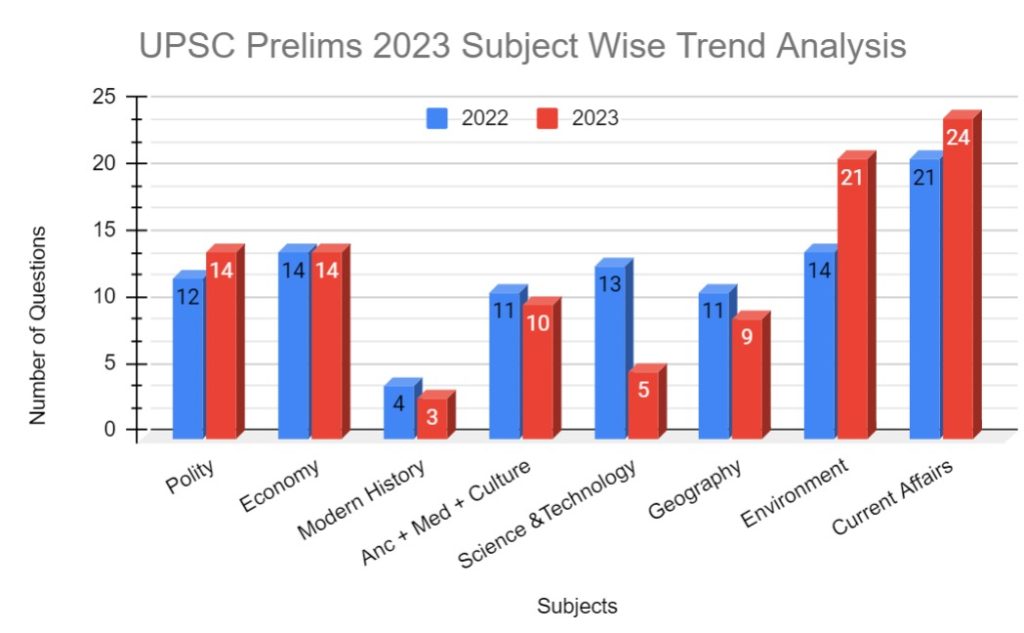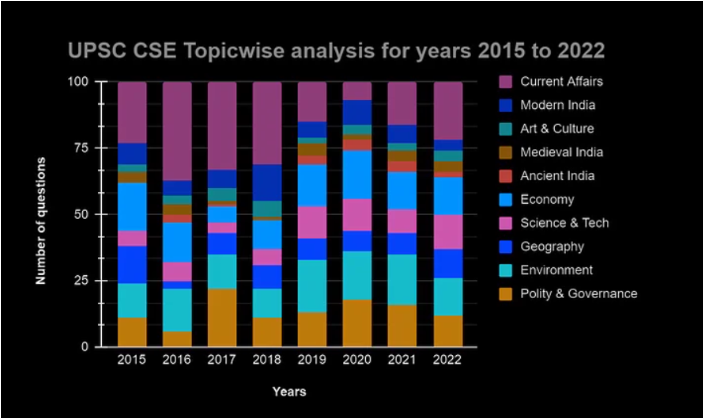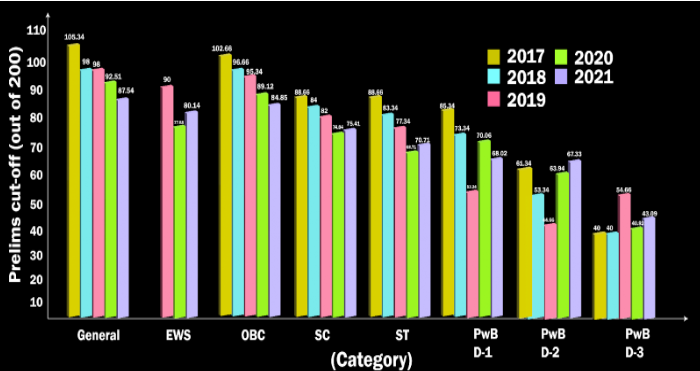UPSC CSE Prelims Paper-I was successfully conducted. The General Studies (GS Paper 1) exam took place from 9:30 AM to 11:30 AM at various centers. According to initial student reactions, the difficulty level of the exam was moderate to difficult, with a major focus on current affairs. The cutoff for the Prelims will be based on the General Studies Paper. An analysis of the exam is available for students, teachers, and parents. Additionally, the UPSC Prelims Paper-II (CSAT) is scheduled to be held on the same day from 2:30 PM to 4:30 PM.
The UPSC Prelims 2023 Paper 1 consisted of 100 questions with total of 200 marks. Candidates had a full 2 hours to finish this paper. It’s important for candidates to know that the marks they score in the General Studies Paper will determine if they qualify for the Preliminary cutoff.
Check out for UPSC CSE Answer Key 2023
UPSC Prelims Exam Analysis 2023: Candidates can access the analysis of the UPSC Prelims 2023 Exam. This article provides a PDF of the exam analysis, which can be downloaded by the candidates. The PDF contains information about the exam and its level of difficulty. Additionally, candidates can refer to the table below for an overview of the UPSC Exam Analysis 2023.
| UPSC Prelims Exam Analysis 2023- Overview | |
| Name of Organization | Union Public Service Commission (UPSC) |
| UPSC Exam Date 2023 | 28 May 2023 |
| Category | Exam Analysis |
| Status | Paper I and Paper II Released |
| Official Websites | https://www.upsc.gov.in/ |
The Union Public Service Commission (UPSC) conducted the UPSC Prelims Paper 1 at various centers across the country. According to feedback from students and our subject matter experts, the exam was of moderate difficulty. The IAS Exam Prelims is a multiple-choice question (MCQ) pen and paper test. Prelims Paper 1 is worth 200 marks and has negative marking for incorrect answers. The UPSC Prelims CSAT is a qualifying paper. Here are the highlights of the GS 1 paper:
The analysis of the UPSC IAS Exam 2023 Prelims is extremely important for candidates who are preparing for this highly competitive examination. The UPSC Exam Analysis 2023 helps candidates identify the key areas they need to focus on and prioritize their preparation accordingly. It also allows candidates to assess their performance by comparing their answers with the answer keys or model solutions.
Our subject matter experts have released the UPSC Prelims 2023 Analysis for GS Paper 1. This detailed analysis provides information about the difficulty level of each topic and the questions asked in the exam. The timings for both papers are as follows:
UPSC Prelims Paper 1: 09:30 AM to 11:30 AM
UPSC Prelims Paper 2: 02:30 PM to 04:30 PM
In UPSC Prelims 2023, Paper 1 is the General Studies (GS) Paper, while Paper 2 is the Civil Services Aptitude Test (CSAT). To better understand the Civil Services exam, candidates should review the UPSC Prelims 2023 analysis. Additionally, candidates can also refer to the UPSC Prelims Analysis from previous years to identify any trends.
UPSC Prelims 2023 GS Paper 1 Analysis: Candidates can refer to the comprehensive analysis of UPSC Prelims 2023, which includes the weightage assigned to each section. By reviewing the UPSC Prelims analysis, candidates can understand the level of difficulty of the exam, the number of questions in each section, and other important details. To gain insights into the topic-wise weightage of GS Paper 1, check out the detailed UPSC Paper analysis provided here.
Below is the distribution of topics and their respective weightage for the UPSC Prelims Exam 2023. Look at the number of questions included in UPSC Prelims GS Paper 1 Analysis.
| Subjects | Good Attempts | Difficulty Level |
| Current Affairs | 9 | Moderate |
| Geography and Environment | 36 | Moderate |
| Ancient History | 2 | Difficult |
| Medieval History | 2 | Difficult |
| International Affairs and others | 3 | Moderate |
| Economics and Social Development | 16 |
Moderate to Difficult
|
| Polity | 15 |
Easy to Moderate
|
| Science & Technology | 8 | Moderate |

UPSC Prelims GS CSAT Paper 2 Analysis 2023: Once the UPSC Prelims 2023 exam is over, candidates can access the detailed analysis of GS Paper 2. Those who appeared for the CSAT paper in 2022 and reviewed the UPSC Prelims analysis considered it to be moderately time-consuming. The UPSC Paper analysis will provide valuable insights into the topic-wise weightage of GS Paper 2, helping candidates understand the distribution of marks across different subjects.
Below is the distribution of topics and their respective weightage for the UPSC Prelims Exam 2023. Look at the number of questions in UPSC Prelims Paper
| Sr. No. | Subjects | Total Number of Questions | Difficulty Level |
| 1. | Reasoning Ability | 13-14 | Moderate |
| 2. | Reading Comprehension | 27 | Moderate |
| 3. | Basic Numeracy and Maths (Including Data Sufficiency) | 39-40 | Moderate |
| Total | 80 | Moderate | |
The UPSC Prelims usually have two papers: General Studies Paper 1 and General Studies Paper 2 (CSAT). We have gathered a detailed analysis of the UPSC exam for Prelims 2023, covering each subject. This analysis is based on feedback from experts and responses from students. It will be helpful for aspirants preparing for the UPSC 2024 exam as well.
| UPSC Exam Analysis 2023 GS Paper 1 | ||
| Topics | Number of Question | Level Of Difficulty |
| Current Affairs | 9 | Moderate |
| Geography and Environment | 36 | Moderate |
| Ancient History | 2 | Difficult |
| Medieval History | 2 | Difficult |
| International Affairs and others | 3 | Moderate |
| Economics and Social Development | 16 |
Moderate to Difficult
|
| Polity | 15 |
Easy to Moderate
|
| Science & Technology | 8 | Moderate |
| UPSC Exam Analysis 2023 GS CSAT Paper 2 | ||
| Reasoning Ability | 13-14 | Moderate |
| Reading Comprehension | 27 | Moderate |
| Basic Numeracy and Maths (Including Data Sufficiency) | 39-40 | Moderate |
| Total | 80 | Moderate |
Follow the steps to calculate score for UPSC Prelims 2023.
To calculate your score for the UPSC Prelims 2023 examination, you need to consider GS Paper I and Paper II. In GS Paper I, each correct answer carries 2 marks. For instance, if you have 75 correct answers, your score would be 75 x 2 = 150 marks. However, there is negative marking of 0.33% for each incorrect answer, deducting 0.66 marks for every wrong answer. Let’s say you answered 25 questions incorrectly, resulting in a negative marking of 25 x 0.66 = 16.5. Consequently, 16.5 marks would be deducted from your total score. Hence, the final score for Paper I would be 150 – 16.5 = 133.5 marks.
Moving on to GS Paper II (CSAT), there are 80 questions worth 200 marks, with each question carrying 2.5 marks. If you answered 65 questions correctly and 15 incorrectly, assuming the 15 incorrect answers are from questions 1 to 73 and the 5 incorrect answers are from questions 74 to 80 (decision-making questions), your total score would be as follows: Correct answers: 65 x 2.5 = 162.5 marks Incorrect answers from Q1-73: 15 x 0.83 = 12.45 marks. Therefore, the total score in UPSC Prelims Paper II would be 162.5 – 12.45 = 150.05 marks.
To calculate your overall score in the UPSC Prelims Exam, you need to add the scores from Paper I and Paper II together: 133.5 + 150.05 = 283.55 marks. This would be your candidate’s overall score in the UPSC Prelims Exam.
| UPSC Prelims Previous Years Exam Analysis 2011-2021 | |||||||
| Year | Current affairs | History and Art and Culture | Geography | Politics | Economy | Science Technology | Environment and ecology |
| 2011 | 13 | 11 | 11 | 12 | 19 | 19 | 15 |
| 2012 | 26 | 17 | 12 | 11 | 13 | 9 | 12 |
| 2013 | 28 | 11 | 9 | 13 | 15 | 11 | 13 |
| 2014 | 20 | 17 | 12 | 11 | 10 | 13 | 17 |
| 2015 | 29 | 14 | 14 | 13 | 13 | 7 | 10 |
| 2016 | 27 | 15 | 7 | 7 | 18 | 8 | 18 |
| 2017 | 34 | 14 | 7 | 22 | 8 | 4 | 11 |
| 2018 | 28 | 15 | 8 | 13 | 16 | 7 | 13 |
| 2019 | 22 | 17 | 14 | 15 | 14 | 7 | 11 |
| 2020 | 19 | 19 | 13 | 14 | 14 | 10 | 11 |
| 2021 | 14 | 20 | 10 | 14 | 15 | 12 | 15 |
The UPSC Prelims examination comprises two papers and serves as an elimination round, determining the progression of candidates. Out of approximately 500,000 (on average) individuals who appear for the exam, only around 10,000 to 15,000 candidates successfully clear it. The marks obtained in this examination are crucial in determining the advancement to the next stage. It is essential to prepare diligently and thoroughly understand the subjects included in this examination.
The Prelims papers consist of objective-type questions with negative markings for incorrect responses. The exam structure is as follows:
| Exam Pattern – Prelims | |||||
|---|---|---|---|---|---|
| Paper | Paper Type | Total Questions | Total Marks | Time Duration | Negative marking |
| General Studies I | Objective | 100 | 200 | 2 hours | Yes |
| General Studies II (CSAT) | Objective | 80 | 200 | 2 hours | Yes |
| Total | 400 (GS Paper II is passable in nature with a fixed minimum passing grade of 33%) | ||||
Also, Read – UPSC CSE Prelims 2023 Answer Key
The UPSC Prelims 2023 Paper 1 has been successfully conducted across all exam centers. It was held today, May 28, 2023, in two different shifts. The analysis of the question paper for this exam is now available. The UPSC CSE is a national-level entrance examination conducted by the Union Public Service Commission. It is held to recruit candidates for various Civil Services positions in the Indian government, such as the IAS, IFS, IPS, and more. The UPSC CSE Prelims Question Paper Analysis for 2023 is provided below.
Here are some important points of the UPSC Exam 2023:
In the UPSC Prelims Exam Analysis 2023, we will discuss the following:
You can also download UPSC Question Paper CSAT 2023 PDF.
Access UPSC IAS Prelims Question Papers PDF for Paper 1 and Paper 2 with Set A, B, C, and D
Download links will be provided once the exam is conducted.
| UPSC Prelims GS Question Paper 2023 |
| UPSC Prelims 2023 GS Paper 1- SET A |
| UPSC Prelims 2023 GS Paper 1- SET B |
| UPSC Prelims 2023 GS Paper 1- SET C |
| UPSC Prelims 2023 GS Paper 1- SET D |
| UPSC Prelims CSAT Question Paper 2023 |
| UPSC Prelims 2023 CSAT Paper 1- SET A |
| UPSC Prelims 2023 CSAT Paper 1- SET B |
| UPSC Prelims 2023 CSAT Paper 1- SET C |
| UPSC Prelims 2023 CSAT Paper 1- SET D |
You Can Download UPSC Prelims 2023 GS Paper 1 Answer Key PDF
UPSC Prelims Exam Analysis: Exam Pattern Overview
To prepare for the UPSC Exam, it’s important to understand its pattern. The UPSC Exam consists of three stages:
Preparing for the UPSC Exam requires a comprehensive approach. You must cover both the UPSC Prelims Syllabus and UPSC Mains Syllabus and optional subjects. The UPSC Syllabus is extensive, so having a solid preparation strategy is crucial. It’s recommended to start with basic UPSC Books and NCERT Books for UPSC to establish a solid foundation of knowledge.
Candidates participating in the UPSC Prelims 2023 examination should refer to the UPSC Answer Key to estimate their scores. This is an unofficial Answer Key for UPSC Prelims 2023, and there may be potential errors. The official UPSC Answer Key for Prelims 2023 will be released only after the final results of the UPSC CSE 2023 Examination.
Download UPSC Prelims unofficial Answer Key 2023 in PDF
Download UPSC Answer Key 2023 in Hindi
The official UPSC Answer Key for Prelims 2023 will be released after the all stages of the exam with the final result of the UPSC CSE 2023 Examination. However, for the convenience of candidates, we have estimated the expected UPSC Cut-Off range for UPSC Prelims 2023 based on previous years’ patterns.
Moving forward, the need is to analyze the areas and the contribution they hold in the General Studies Paper 1 of UPSC CSE Prelims.
Knowing this you can make out the high-yielding areas priority list and schedule accordingly, be it core preparation or revision before Prelims.
| Topics/
Subjects |
2015 | 2016 | 2017 | 2018 | 2019 | 2020 | 2021 | 2022 |
|---|---|---|---|---|---|---|---|---|
| Polity & Governance | 11 | 6 | 22 | 11 | 13 | 18 | 16 | 12 |
| Environment | 13 | 16 | 13 | 11 | 20 | 18 | 19 | 14 |
| Geography | 14 | 3 | 8 | 9 | 8 | 8 | 8 | 11 |
| Science & Tech | 6 | 7 | 4 | 6 | 12 | 12 | 9 | 13 |
| Economy | 18 | 15 | 6 | 11 | 16 | 18 | 14 | 14 |
| Ancient India | 0 | 3 | 1 | 0 | 3 | 4 | 4 | 2 |
| Medieval India | 4 | 4 | 1 | 1 | 5 | 2 | 4 | 4 |
| Art & Culture | 3 | 3 | 5 | 6 | 2 | 4 | 3 | 4 |
| Modern India | 8 | 6 | 7 | 14 | 6 | 9 | 7 | 4 |
| Current Affairs | 23 | 37 | 33 | 31 | 15 | 7 | 16 | 22 |
| Total | 100 | 100 | 100 | 100 | 100 | 100 | 100 | 100 |
A graphical representation would be-

From the above table and graph, it can be inferred that – Polity, Environment, Geography, Science & Technology, and Economy, alone cover 50% of the questions. Current Affairs forms a significant part of the question paper. Further, these topics form the basis for the Mains GS and essay papers. A good strategy can be to prepare these topics rigorously in a planned and documented manner.
Past Years’ UPSC Prelims Cut-Off Trends
As you already know, Prelims Cutoff consists of a cutoff calculated out of General Studies Paper-1 and not General Studies Paper-2 because that is qualifying in nature and requires you to score a minimum of 33%.
Below are the cut-offs of last five years followed by its trend analysis-
| Category | 2021
(Out of 200) |
2020
(Out of 200) |
2019
(Out of 200) |
2018
(Out of 200) |
2017
(Out of 200) |
| General | 87.54 | 92.51 | 98 | 98 | 105.34 |
| EWS | 80.14 | 77.55 | 90 | – | – |
| OBC | 84.85 | 89.12 | 95.34 | 96.66 | 102.66 |
| SC | 75.41 | 74.84 | 82 | 84 | 88.66 |
| ST | 70.71 | 68.71 | 77.34 | 83.34 | 88.66 |
| PwB
D-1 |
68.02 | 70.06 | 53.34 | 73.34 | 85.34 |
| PwB
D-2 |
67.33 | 63.94 | 44.66 | 53.34 | 61.34 |
| PwB
D-3 |
43.09 | 40.82 | 54.66 | 40 | 40.00 |

From the above trend, it might seem that in the subsequent years, merit is getting lower but do not go by the numbers; it is the difficulty level that is regulating these merit numbers.
| The following articles given in the table below can be referred to for UPSC IAS exam preparation: | |
| UPSC IAS Interview Courses | IAS Interview Questions Download |
| Old Interview Transcriptions | UPSC Interview Marks |
| UPSC IAS Interview 2023 | Notes For UPSC Interview |
Frequently Asked Questions(FAQs)
Q1:What is success rate of UPSC Prelims?
Ans: The success rate of UPSC Prelims varies each year, but on average, it is around 2% to 3%.
Q2:Which subject has more weightage in UPSC Prelims?
Ans: Current affairs holds significant weightage in UPSC Prelims.
Q3:Is 6 months current affairs enough for UPSC Prelims?
Ans: Yes, studying current affairs from the last 6 months is generally considered sufficient for UPSC Prelims preparation.
Q4:Is 1-year current affairs enough for UPSC?
Ans: Yes, studying current affairs from the last 1 year is generally considered sufficient for UPSC preparation.
Q5:Is UPSC Prelims very hard?
Ans: Yes, UPSC Prelims is considered to be a challenging examination.

<div class="new-fform">
</div>